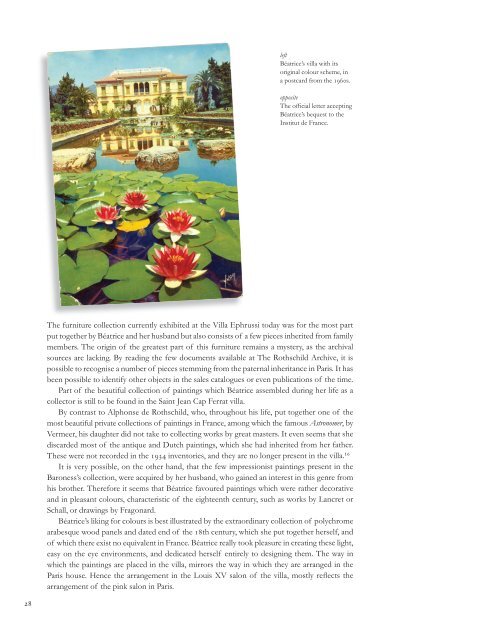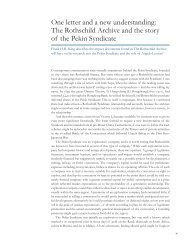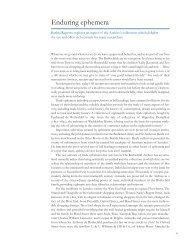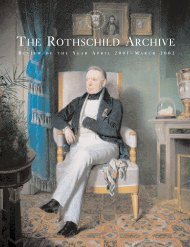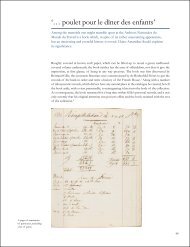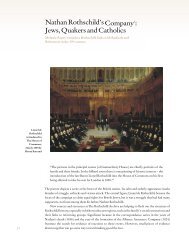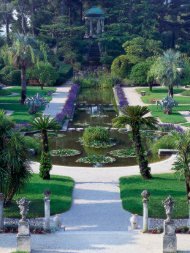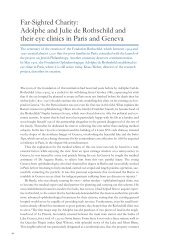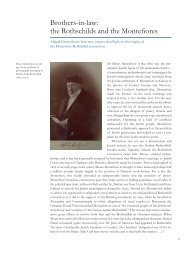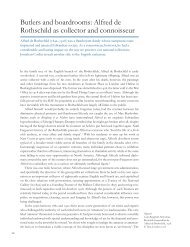Beatrice Ephrussi de Rothschild: creator and collector
Beatrice Ephrussi de Rothschild: creator and collector
Beatrice Ephrussi de Rothschild: creator and collector
You also want an ePaper? Increase the reach of your titles
YUMPU automatically turns print PDFs into web optimized ePapers that Google loves.
left<br />
Béatrice’s villa with its<br />
original colour scheme, in<br />
a postcard from the 1960s.<br />
opposite<br />
The official letter accepting<br />
Béatrice’s bequest to the<br />
Institut <strong>de</strong> France.<br />
The furniture collection currently exhibited at the Villa <strong>Ephrussi</strong> today was for the most part<br />
put together by Béatrice <strong>and</strong> her husb<strong>and</strong> but also consists of a few pieces inherited from family<br />
members. The origin of the greatest part of this furniture remains a mystery, as the archival<br />
sources are lacking. By reading the few documents available at The <strong>Rothschild</strong> Archive, it is<br />
possible to recognise a number of pieces stemming from the paternal inheritance in Paris. It has<br />
been possible to i<strong>de</strong>ntify other objects in the sales catalogues or even publications of the time.<br />
Part of the beautiful collection of paintings which Béatrice assembled during her life as a<br />
<strong>collector</strong> is still to be found in the Saint Jean Cap Ferrat villa.<br />
By contrast to Alphonse <strong>de</strong> <strong>Rothschild</strong>, who, throughout his life, put together one of the<br />
most beautiful private collections of paintings in France, among which the famous Astronomer, by<br />
Vermeer, his daughter did not take to collecting works by great masters. It even seems that she<br />
discar<strong>de</strong>d most of the antique <strong>and</strong> Dutch paintings, which she had inherited from her father.<br />
These were not recor<strong>de</strong>d in the 1934 inventories, <strong>and</strong> they are no longer present in the villa.¹⁶<br />
It is very possible, on the other h<strong>and</strong>, that the few impressionist paintings present in the<br />
Baroness’s collection, were acquired by her husb<strong>and</strong>, who gained an interest in this genre from<br />
his brother. Therefore it seems that Béatrice favoured paintings which were rather <strong>de</strong>corative<br />
<strong>and</strong> in pleasant colours, characteristic of the eighteenth century, such as works by Lancret or<br />
Schall, or drawings by Fragonard.<br />
Béatrice’s liking for colours is best illustrated by the extraordinary collection of polychrome<br />
arabesque wood panels <strong>and</strong> dated end of the 18th century, which she put together herself, <strong>and</strong><br />
of which there exist no equivalent in France. Béatrice really took pleasure in creating these light,<br />
easy on the eye environments, <strong>and</strong> <strong>de</strong>dicated herself entirely to <strong>de</strong>signing them. The way in<br />
which the paintings are placed in the villa, mirrors the way in which they are arranged in the<br />
Paris house. Hence the arrangement in the Louis XV salon of the villa, mostly reflects the<br />
arrangement of the pink salon in Paris.<br />
28


